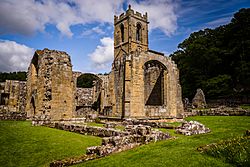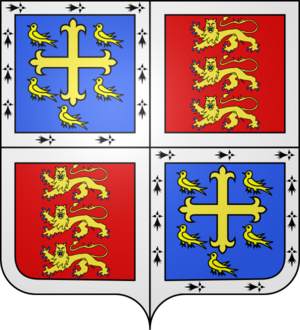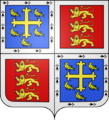Mount Grace Priory facts for kids

Mount Grace Priory
|
|
| Monastery information | |
|---|---|
| Order | Carthusian |
| Established | 1398 |
| Disestablished | 1539 |
| Dedicated to | House of the Assumption of the Blessed Virgin and of St Nicholas |
| Diocese | York |
| People | |
| Founder(s) | Thomas de Holand, Earl of Kent and Duke of Surrey |
| Site | |
| Location | East Harlsey, North Yorkshire, England |
| Coordinates | 54°22′48″N 1°18′40″W / 54.380120°N 1.311077°W |
| Visible remains | church, cloister, inner court and earthworks |
| Public access | yes (English Heritage) |
Mount Grace Priory is a special place in East Harlsey, North Yorkshire, England. It's located in the beautiful woodlands of the North York Moors National Park. This priory is the best-preserved and easiest to visit among the nine houses of the Carthusian Order that once existed in England during the Middle Ages. These houses were also known as charterhouses.
The Mount Grace Charterhouse was started in 1398 by Thomas Holland, 1st Duke of Surrey. He was the son of King Richard II's half-brother. This was the very last monastery built in Yorkshire. It was also one of the few built anywhere in Britain between the time of the Black Death (1349–50) and the Reformation. It was a fairly small place, designed for a leader (called a prior) and up to twenty-three monks.
The monastery had a church and two main courtyards, called cloisters. The Great Cloister, north of the church, had seventeen small houses for the main monks. The smaller Lesser Cloister, to the south, had six houses for the lay brothers.
After King Richard II was no longer king and later died, Thomas Holland and others who supported the king tried to remove the new king, Henry IV. They were caught and executed in 1400. Holland's body was later moved and buried at the charterhouse he had founded in 1412. Because of these events, Mount Grace lost its founder and the money he had given it. For more than ten years, the priory had to rely on gifts from the new king to survive.
Contents
Life as a Carthusian Monk
When it was founded, Thomas Holland said that the monks should pray for the king, queen, royal family, and for himself and his family. The head of the Carthusian Order allowed him to choose Robert Tredwye as the first leader. The priory was dedicated to "the Blessed Virgin and Saint Nicholas". Over time, it became known simply as the House of the Assumption of the most Blessed Virgin in Mount Grace.
Nicholas Love, who became the prior of Mount Grace, helped the priory connect with the new royal family. He did this by sharing his book, "Mirror of the Blessed Life of Jesus Christ," with the Archbishop of Canterbury. This helped the priory gain support and receive important gifts. In 1410, the house officially became part of the Carthusian Order, and Love was named the first prior.
The priory received many important gifts and permissions over the years:
- In 1399, King Richard II gave the monks special rights, including permission to mine lead.
- Later that year, they were given control of several smaller monasteries in other parts of England, like Hinckley and Carisbrooke. They also received lands in France for a time.
- When some of these lands were lost, King Henry IV promised the monks money each year and even a barrel of good red wine from Gascony!
- Later kings, like Henry V, continued to give the priory more lands and money. These gifts helped the priory grow and support more monks.
In 1439, the priory asked the government to confirm their ownership of their lands. This was because many people were claiming parts of their estate. King Henry VI agreed in 1440, which allowed the priory to continue building. After this, more gifts kept coming:
- In 1456, a local noble family, the Strangways, gave the priory control over a church in Derbyshire.
- In 1462, the king gave them control of a manor (a large estate) in Warwickshire to help the poor.
- In 1508, the Prior of Mount Grace leased a chapel and manor to another priory for a yearly payment.
- In 1522, a will mentioned a special Lady Chapel at Mount Grace, where a priest would say masses.
Important Writings
Mount Grace became a very important place for creating and keeping religious books. Monks like John Norton and Richard Methley lived and wrote there. Richard Methley translated important spiritual texts into Latin. The only surviving copy of The Book of Margery Kempe, a famous medieval book, also belonged to Mount Grace Charterhouse.
The Priory's Closure
The priory was closed in 1539 during the time when King Henry VIII was closing down many monasteries in England. Some of the monks tried to resist taking an oath that said the king was the head of the church, not the Pope. After they were put in prison, the last prior, John Wilson, gave the keys to the king's representatives. The land then became private property.
Mount Grace was valued at a large sum of money at the time. The monks were given pensions, which were yearly payments, to help them after the priory closed. The prior received a larger sum and was allowed to keep a house and chapel.
A Monk's Daily Life
Unlike monks from other groups who lived together, Carthusian monks lived more like hermits. Each monk had his own small house, called a cell. They only came together for prayers at night and on Sundays and special feast days in the church. They would sing other prayers alone in their cells. Carthusian monks were mostly silent, except for singing during church services and talking about "serious topics" during a weekly three-hour walk. Their diet was also strictly vegetarian.
The monks at Mount Grace were very careful about cleanliness. In the reconstructed monk's cell, you can see a toilet area and learn about the ditches they used for their sewage system.
After the Closure
After the priory closed, parts of the old guest-house were used to build two new houses. One was a manor house built in the 1600s. The other, larger house was built around 1900 and is a great example of the Arts and Crafts movement style. The Manor House was decorated in this style when it was owned by a wealthy ironmaster named Sir Isaac Lowthian Bell.
Visiting Today
Today, the National Trust owns Mount Grace Priory, and English Heritage takes care of it.
Visitors can explore the layout of the entire monastery. You can see a reconstructed monk's cell, the small Carthusian church, and the later houses. There's also a museum on site that tells the story of the priory. English Heritage even lets out the Prior's Lodge as a holiday cottage!
Images for kids





